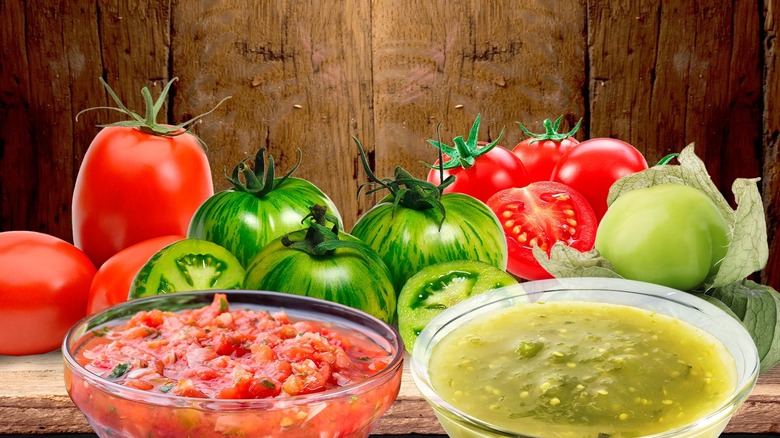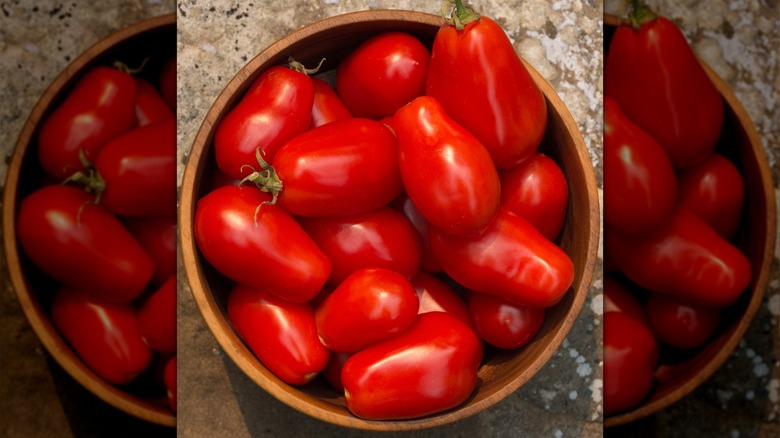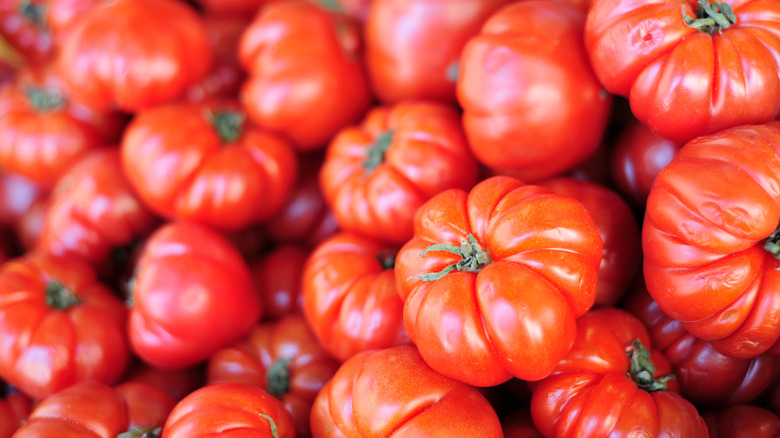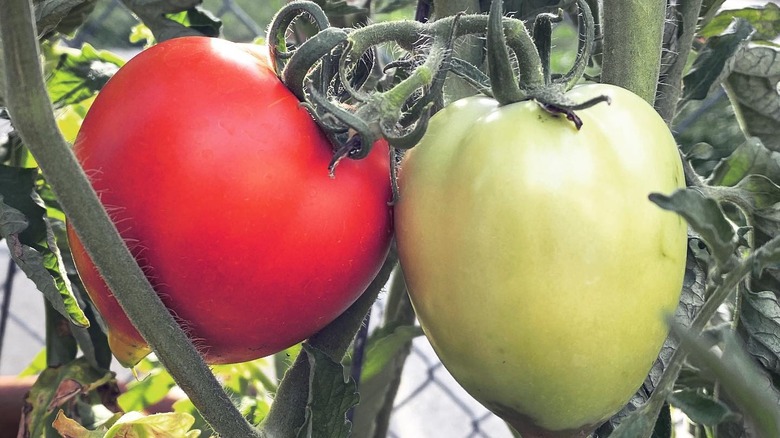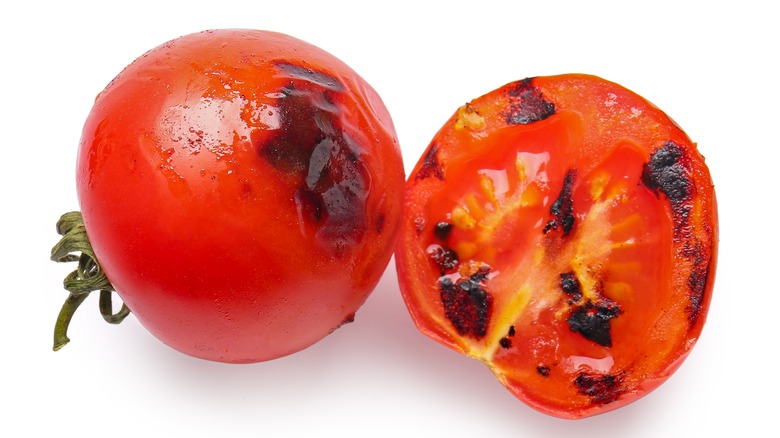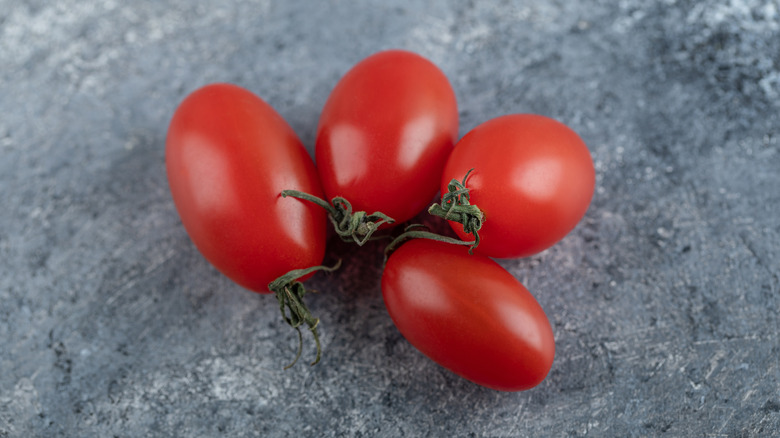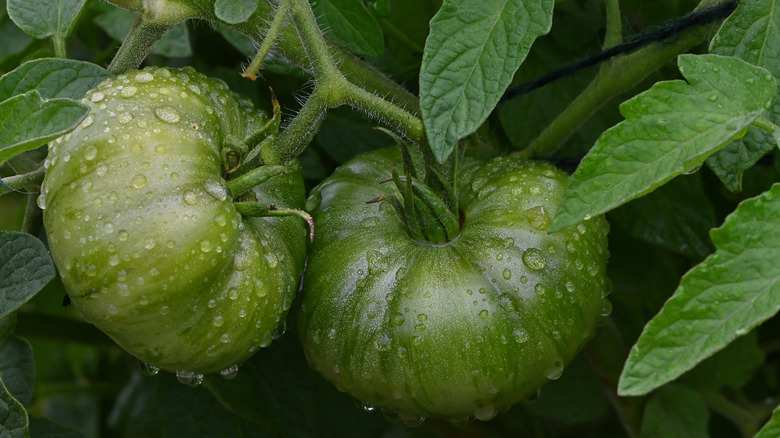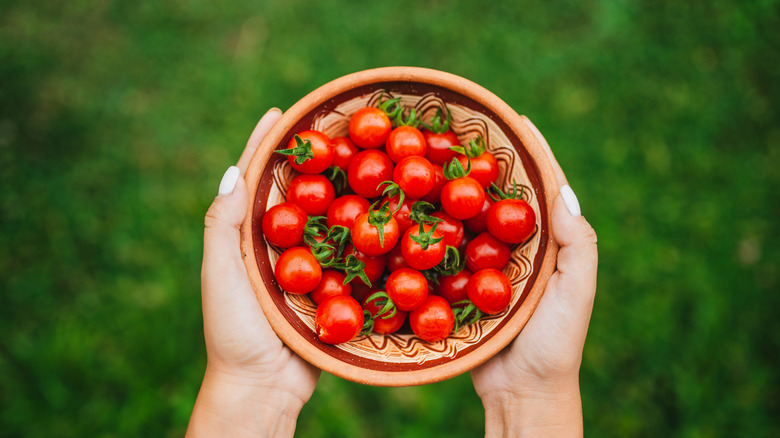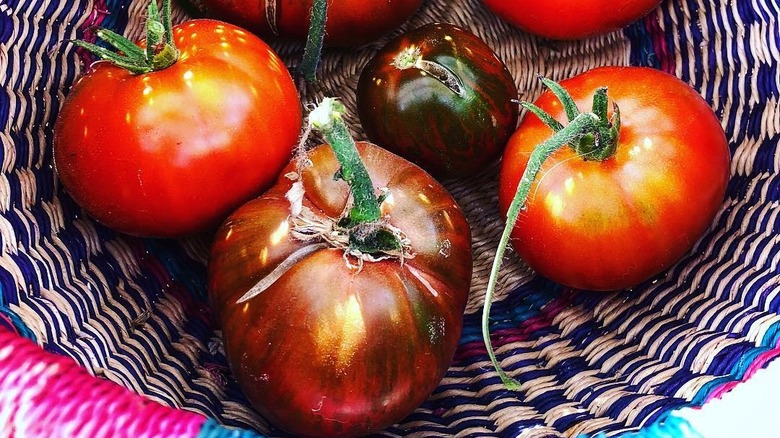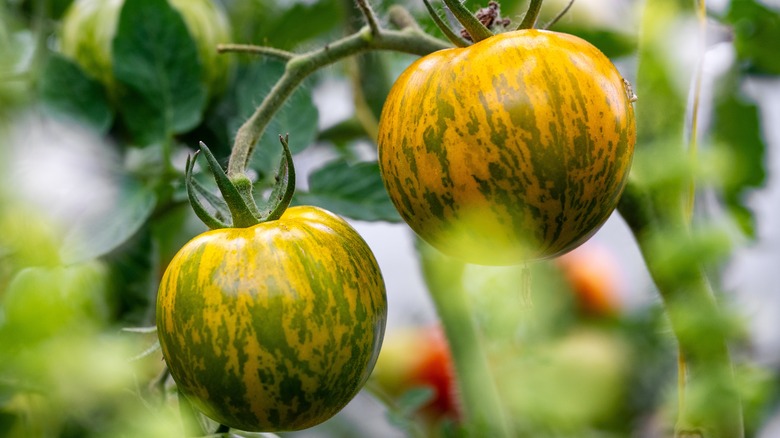The Best Chef-Approved Tomato Varieties For Making Salsa
With over 10,000 varieties of tomatoes to choose from and with dozens of ways to use fresh tomatoes, it can be a daunting task to find the perfect option for any given recipe. But if you're eager to make your favorite salsa, we can help you narrow down your selection.
From those that taste delicious and flavorful right off the vine to those that are better roasted and charred, countless tomatoes fit the bill for any given salsa recipe. But to create the most delicious salsa possible — from pico de gallo, to salsa verde, to salsa roja — it's imperative to pick the perfect tomato variety to nail the flavor and texture.
After extensive research and speaking to experts like Chef Iliana de la Vega, head chef at Austin-based restaurant El Naranjo, we've rounded up the best options for your next venture into salsa-making. Read on to discover the best tomato varieties for making salsa.
Roma Tomatoes
Roma tomatoes – a type of paste tomato – are great for fresh salsas like pico de gallo because they have lower water content. This meaty tomato variety is also high in sugar and acid, helping create a sweet and rich flavor. Romas also have fewer seeds and, as a result, more flesh. This helps to prevent bitterness and wateriness that can ruin your final product.
While Roma tomatoes are often used for tomato sauce, tomato paste, or even sauces like ketchup, they are also a common favorite for salsas – and top the list of de la Vega's favorite varieties. "For all the salsas in the U.S., I use Romas. I prefer Roma tomatoes as they are packed with flavor, flesh, and little water content, so the flavor is even more intense."
They're also perfect for making her favorite salsa: "[Using Romas,] I love to make a roasted tomato and serrano salsa – preferably in a molcajete."
Beefsteak Tomatoes
While Beefsteak tomatoes are often used raw in classic sandwiches like BLTs or tomato sandwiches, they are also the ideal candidate for fresh salsas. Beefsteak tomatoes have many similar characteristics to Romas — they are juicy, meaty, and have high acid levels. Though they are larger and rounder than the oval-shaped Roma tomatoes, Beefsteak tomatoes are still a perfect option for pico de gallo or blended salsas like salsa roja.
While Romas have high acidity levels, Beefsteak tomatoes are even more acidic, giving salsa a little more tang — but a slightly less intense tomato flavor overall according to de la Vega. "These tomatoes are rather light in their 'tomato' taste," she explained.
In addition to salsa, Beefsteak tomatoes are a great all-purpose option to have in the kitchen for things like sandwiches, burgers, or sauces. Just be sure to pick tomatoes that are at their peak to maximize juiciness and flavor. Look for ones that are firm with a bit of give, and opt for those that are a vibrant deep red hue. Avoid those with pale coloring or that are super firm (this indicates they aren't yet ripe) or tomatoes with bruises or cracks.
Big Mama Tomatoes
True to their name, Big Mama tomatoes can grow up to 5 inches long, 3 inches in diameter. Though the oval shape and membership in the "paste tomato" family may at first make them seem almost identical to Roma tomatoes, they also have their own distinct characteristics.
Like Romas, they have a low water content and few seeds, and the tomato skins peel off easily after boiling. This makes them a natural fit for both pico de gallo and blended salsa recipes with a smoother texture.
Big Mama tomatoes, according to reviews, are also typically a high-yield crop. Perfect for experienced and amateur gardeners alike, you can add these tomatoes to your garden to enjoy delicious salsas and sauces in late summer and early fall when they ripen. If you have extra fruit left over, consider using the juicy tomatoes for raw preparation in sandwiches in sauces or preserved preparations like tomato sauce or tomato soup.
Fire-Roasted Canned Tomatoes
If you want salsa without adding an extra trip to the grocery store, always keep a can of fire-roasted tomatoes in your pantry. This versatile, affordable staple can be used in many ways, but one of our favorites is a fast and delicious blended salsa. While certain salsas (like pico de gallo) require fresh tomatoes, don't discount recipes made with canned alternatives — and especially with flavorful fire-roasted varieties.
Typically, fire-roasted tomatoes are made using Roma tomatoes that have a naturally sweet and acidic flavor. They are then charred before they are canned, infusing the tomatoes with a smoky, umami taste. Sometimes, they also have added spices, like garlic or onion powder, to add even more complexity. This depth of flavor pairs perfectly with salsa roja or fire-roasted salsa recipes for a flavorful final result. Just be sure to drain the water before blending your salsa to keep the smoky, rich flavor as concentrated as possible.
Amish Paste Tomatoes
Amish Paste tomatoes are a type of plum tomato. This means they have low water content, fewer seeds, and a sweet, slightly acidic flavor. Like other plum varieties, these characteristics make them perfect for fresh salsas.
Instead of using them fresh, you can also roast the tomatoes to caramelize the sugar and create a blended salsa with a distinctly sweet, smoky flavor. Amish Paste tomatoes' sweetness also pairs well with fruit, making it the ideal variety for fruit salsas like pineapple or mango. It can also hold its own against spicy ingredients like jalapeños or chilies for maximum versatility.
When choosing Amish Paste tomatoes — and any other varieties — be sure to choose the ripest tomatoes for the best flavor. "First and foremost the tomato has to be ripe. You know it's ripe when the tomato is relatively deep in color and shiny on the outside," said de la Vega.
Unripe Green Tomatoes
While tomatillos are most commonly used for green salsa, you can also opt to make it using unripened green tomatoes as well. While these two ingredients may look similar, they are completely separate fruits and should each be prepared differently when making salsa. Though green tomatoes are commonly associated with a fried preparation, you can also eat them raw to add a unique twist to your favorite salsa recipes.
Unlike ripe tomatoes, green tomatoes are firm and acidic. They aren't particularly juicy, so they aren't the best option for blended salsas. The tart, citrus flavor, however, is delicious in fresh salsa variations. This often-overlooked tomato will instantly add flavor and acidity to your recipe. Or, if you prefer a milder version, you can roast the unripened tomatoes to mellow them out a bit. The resulting flavor is perfect to use in place of tomatillos in your favorite salsa verde recipe.
Cherry Tomatoes
Cherry tomatoes are known most for their sweetness, and because of their petite size, the intensity of flavor outpaces larger tomato varieties. Though there are different varieties of cherry tomatoes, all of them tend to be juicy and bright. While the small size of these tomatoes makes them perfect for snacking or salads, they can also be used to create a tasty, fresh salsa.
You can eat cherry tomatoes in both blended salsas, like salsa roja, or in chunkier fresh salsa like pico. Like other tomatoes, you can also roast them first for a smokier, bolder final flavor. Or, if you prefer a salsa with lower acidity levels, look for yellow or orange cherry tomatoes (or for a beautiful medley of colors), or consider also incorporating yellow or orange cherry tomatoes for lower acidity levels. Just take note, however, that some people don't enjoy cherry tomatoes in their salsa because of the increased amount of tomato skin.
Thessaloniki Tomatoes
This heirloom tomato variety is known for its "slightly sweet, berry-like flavor and a tart aftertaste." First brought into the U.S. in the 1950s and grown from seeds received from the Ministry of Agriculture Farm in Greece, this tomato is designed to thrive in high-heat environments thanks to its Mediterranean origins. This trait makes them an especially good option for home gardeners because they are resistant to drought, cracking, and sunburn.
While these mild tomatoes are easy to grow, they are also delicious when eaten raw on salads like a traditional Caprese or sandwiches like a Southern-style tomato. They're also an amazing and less commonly used variety for salsa. Like Romas, they are juicy with firm flesh, and offer a classic tomato flavor thanks to a bright burst of acidity. They also ripen well over time, so you can buy them before you need them without worrying they will spoil.
Green Zebra Tomatoes
Unlike unripe green tomatoes, Green Zebra tomatoes remain green or yellow — even as they ripen. This variety gets its name from the distinct vertical stripe that runs around the exterior of the fruit. It's an heirloom fruit that has been created from a blend of four other tomato varieties, creating a unique appearance and flavor.
While these tomatoes may look like tomatillos or unripened tomatoes, their flavor is very different. They are more tart and tangy than red tomatoes, but once ripe, they are not nearly as acidic as unripe green tomatoes.
While these tomatoes can be used in traditional pico de gallo recipes, consider trying something new. Instead, offset the sweetness of the tomatoes with a little heat from a spicy pepper like jalapeño or habanero for a beautiful balance. The only downside to these tomatoes? They aren't as widely available in the supermarket as classics like Roma or Beefsteak tomatoes, so it might be harder to get your hands on them. If you have a green thumb, they're a fairly easy option to grow at home – even for amateur gardeners.
